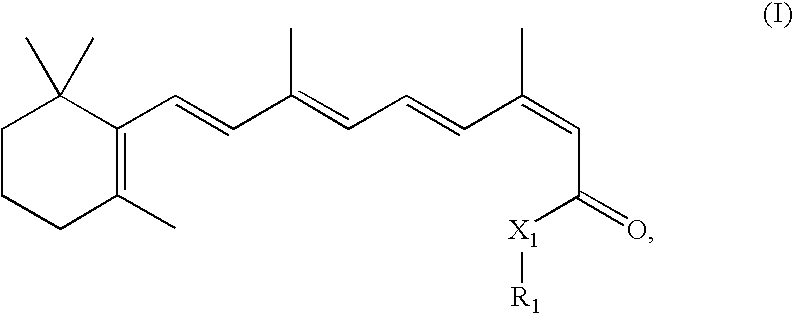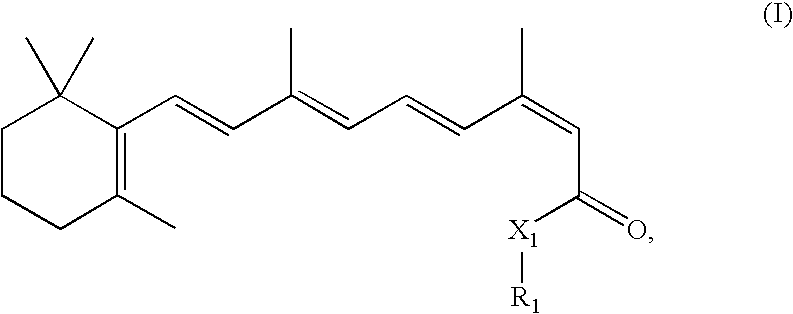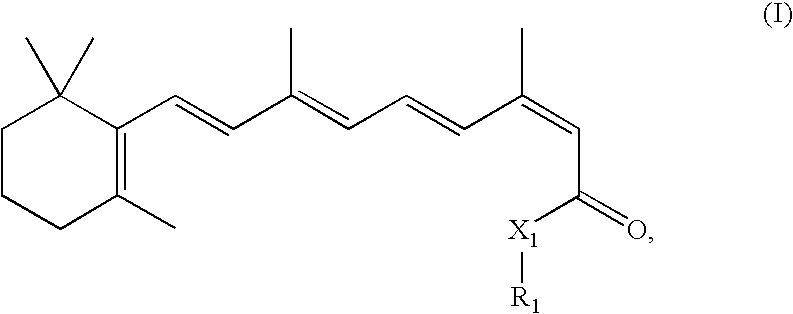Combination Methods and Therapies for Treating Opthalmic Conditions with 13-Cis-Retinyl Derivatives
a technology of n-retinylethanolamine and cis-retinyl, which is applied in the direction of anti-noxious agents, phosphorous compound active ingredients, metabolic disorders, etc., can solve the problems of n-retinylidene-n-retinylethanolamine formation, drusen formation, and adverse effects, so as to reduce the formation of lipofuscin and potentially drusen under the macula, reduce the formation of n-retinyliden
- Summary
- Abstract
- Description
- Claims
- Application Information
AI Technical Summary
Benefits of technology
Problems solved by technology
Method used
Image
Examples
example 1
Testing for the Efficacy of Compounds of Formula (I) in Combination with a Second Agent to Treat Macular Degeneration
[0188]For pre-testing, all human patients undergo a routine ophthalmologic examination including fluorescein angiography, measurement of visual acuity, electrophysiologic parameters and biochemical and rheologic parameters. Inclusion criteria are as follows: visual acuity between 20 / 160 and 20 / 32 in at least one eye and signs of ARMD such as drusen, areolar atrophy, pigment clumping, pigment epithelium detachment, or subretinal neovascularization. Patients with any of the following are excluded from the study: dementia; severe cardiac disease; history of malignancy or infection with hepatitis, or Treponema pallidum; and suitability for laser coagulation according to the guidelines of the Macular Photocoagulation Study Group (Arch Opthalmol 1991; 10:1 109-1114). Details from Brunner et al. Retina 2000; 20:483-491.
[0189]Fifty human patients diagnosed with macular degene...
example 2
Testing for the Efficacy of Compounds of Formula (I) in Combination with a Second Agent to Reduce A2E Production
[0197]The same pre-testing, administration and toxicity evaluation protocols are used as in Example 1. One method for measuring progressive formation of A2E in both control and experimental groups includes the use of a confocal scanning laser opthalmoscope. See Bindewald, et al., Am. J. Opthalmol., 137:556-8 (2004). Documentation of morphologic changes may include changes in (a) drusen size, character, and distribution (b) development and progression of choroidal neovascularization and (c) other interval fundus changes or abnormalities.
[0198]To assess statistically visual improvement during drug administration, examiners may use the ETDRS (LogMAR) chart and a standardized refraction and visual acuity protocol. Evaluation of the mean ETDRS (LogMAR) best corrected visual acuity (BCVA) from baseline through the available posttreatment interval visits can aid in determining st...
example 3
Testing for the Efficacy of Compounds of Formula (I) in Combination with a Second Agent to Reduce Lipofuscin Production
[0200]The same pre-testing, administration and toxicity evaluation protocols are used as in Example 1. One method for measuring progressive formation of lipofuscin in both control and experimental groups includes the use of a confocal scanning laser opthalmoscope. Documentation of morphologic changes may include changes in (a) drusen size, character, and distribution (b) development and progression of choroidal neovascularization and (c) other interval fundus changes or abnormalities.
[0201]To assess statistically visual improvement during drug administration, examiners may use the ETDRS (LogMAR) chart and a standardized refraction and visual acuity protocol. Evaluation of the mean ETDRS (LogMAR) best corrected visual acuity (BCVA) from baseline through the available posttreatment interval visits can aid in determining statistical visual improvement.
[0202]To assess t...
PUM
 Login to View More
Login to View More Abstract
Description
Claims
Application Information
 Login to View More
Login to View More - R&D
- Intellectual Property
- Life Sciences
- Materials
- Tech Scout
- Unparalleled Data Quality
- Higher Quality Content
- 60% Fewer Hallucinations
Browse by: Latest US Patents, China's latest patents, Technical Efficacy Thesaurus, Application Domain, Technology Topic, Popular Technical Reports.
© 2025 PatSnap. All rights reserved.Legal|Privacy policy|Modern Slavery Act Transparency Statement|Sitemap|About US| Contact US: help@patsnap.com



